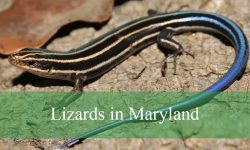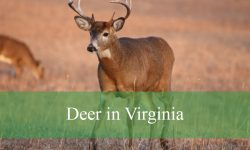Black and white duck breeds are renowned for their striking plumage, blending contrasting colors in various patterns. These ducks, like the Magpie, Ancona, and Swedish Blue, display a dominant mix of black and white feathers across their bodies. Each breed has its own unique characteristics: the Magpie with its black crest and distinctive markings; the Ancona with scattered black dots on a white background; and the Swedish Blue, known for its grayish-blue hue amidst black and white tones.
Keep reading to learn more about various black and white duck breeds, as well as their characteristics and identification methods.
Different Black and White Duck Breeds
Lesser Scaup
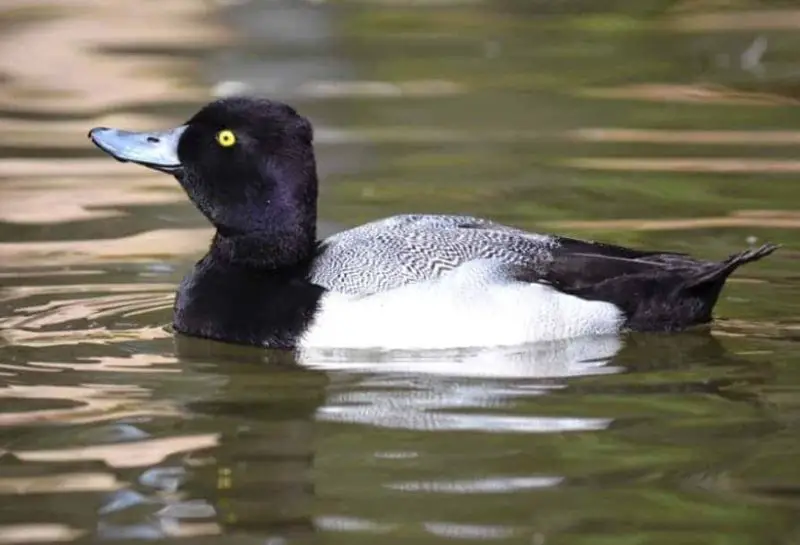
The Lesser Scaup (Aythya affinis), often called the Little Bluebill, is recognized for its blue beak in both males and females. Males exhibit black and white plumage with green iridescence on the back of their heads during the breeding season. Their underbellies are bright white. Females, predominantly dark and bright brown, also have blue beaks but with black patterns at the front. Unlike males’ bright yellow eyes, females have brown irises year-round.
Common Eider
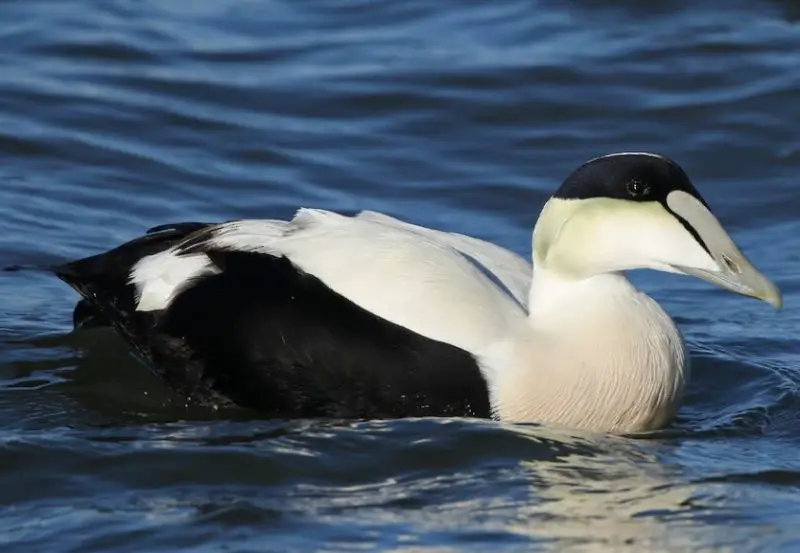
The Common Eider (Somateria mollissima), the largest type of eider, displays distinctive black-and-white plumage. Males in eclipse plumage are mostly black with white patterns and a bright blue beak. Non-eclipse plumage features white with black patterns, a gray-blue beak, and a black crown. Females are predominantly gray and black, appearing almost entirely dark. They have a gray-brown beak, a black tail, and dark brown legs. Females are known for lining their nests with their down feathers for added thermal protection for eggs.
Long-Tailed Duck
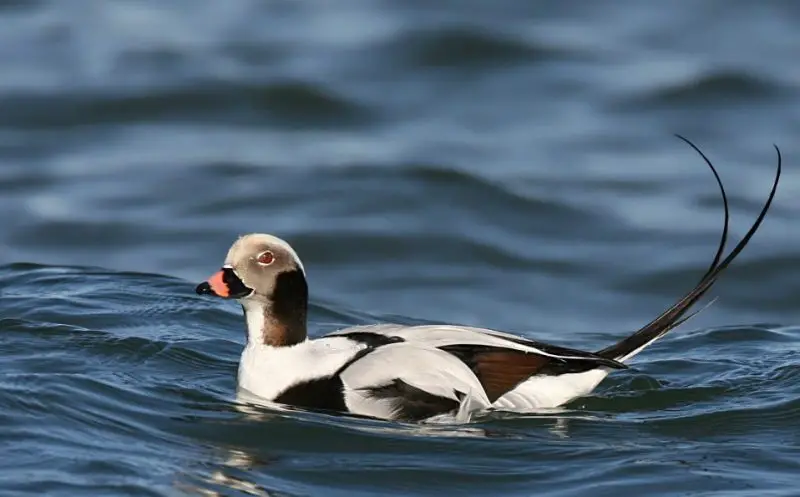
The Long-tailed Duck (Clangula hyemalis) is distinguished by its black, pointed tail and notable differences between males and females. Males have a white crown, gray face, and black back of the head, with a mostly white neck and underbelly. Their wings display black and white patterns, and they feature black and orange beaks with red-brown eyes during breeding. Females are primarily brown, with a white head and dark brown nuances. Ducklings resemble females but have a distinct bright neckband.
Barrow’s Goldeneye
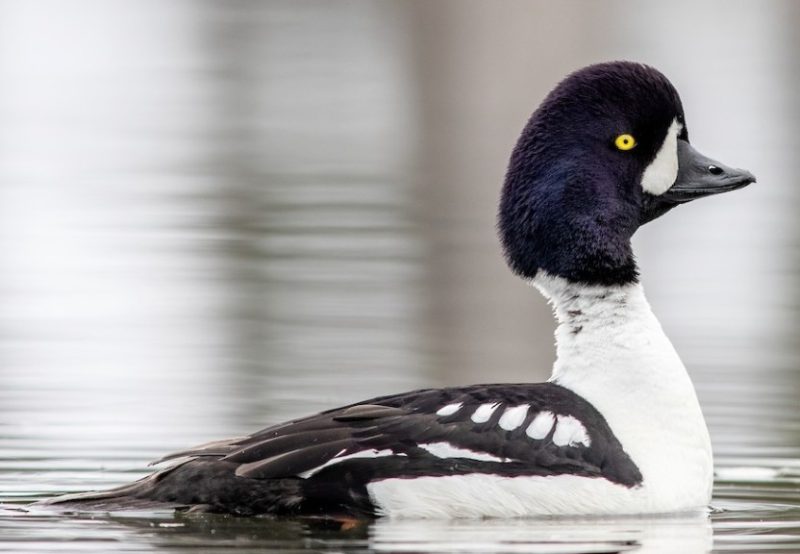
Barrow’s Goldeneye (Bucephala islandica) are black and white seaducks known for the golden-yellow irises of males. Found primarily in Northwestern North America, they reside year-round or migrate short distances along the West Coast from Alaska to the United States. Males feature a mostly black head with white cheeks, a black beak, and a white neck, underbelly, and wings with black sections on the back and tail. Females are brown and off-white, while males develop a green iridescent head during breeding. They feed on mussels and other aquatic prey.
Bufflehead
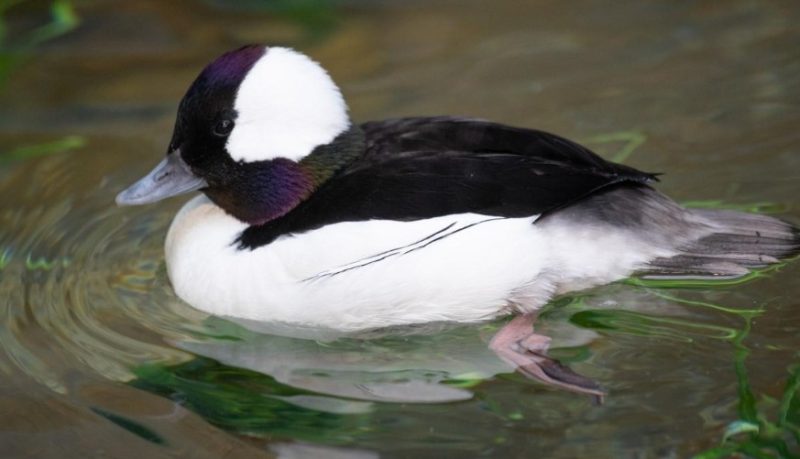
The Bufflehead (Bucephala albeola) is among North America’s smaller ducks, measuring up to 14 inches. Males display black and white patterns with iridescent green and purple on their heads, complemented by short gray beaks. Females have darker beaks and mostly black heads with white side stripes, alongside gray and black undersides. Buffleheads, found across the continent during migration, inhabit regions from Alaska to California and extend eastward to the East Coast.
Common Goldeneye
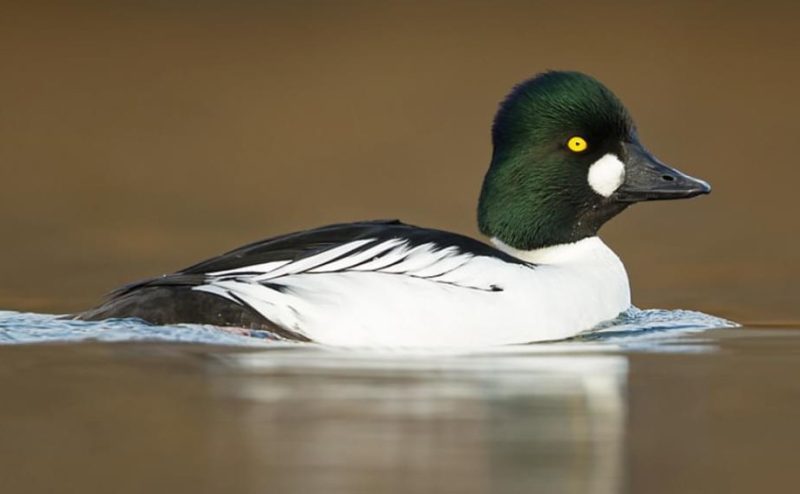
Common Goldeneye ducks (Bucephala clangula) are slightly larger than Buffleheads and exhibit green iridescence on their heads, especially during breeding season. Males sport predominantly black and white plumage with iridescent green heads, yellow eyes, and short black beaks. Females have brown heads, yellow eyes, and gray undersides, with white patches on their wings and dark brown sections on their bodies. Two subspecies exist: one predominant in North America and the other in Eurasia, each with slight variations in plumage.
Common Shelduck
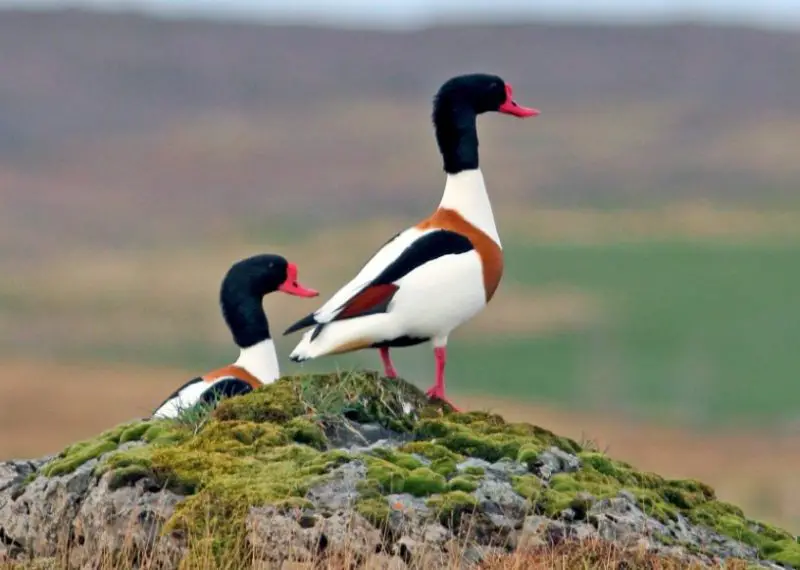
Common Shelducks (Tadorna tadorna) exhibit typical black, white, red, and brown coloring. Breeding males feature green iridescence on the wings’ inner lower part, unlike on the head. Their heads are mostly black, with black and white wings and a white underside. Males sport a vivid red beak, while females have a pale pink-red one. Females have brown heads and large white sections on the chest, underbelly, and wings. Ducklings of this European species are exclusively black and white.
Comb Duck
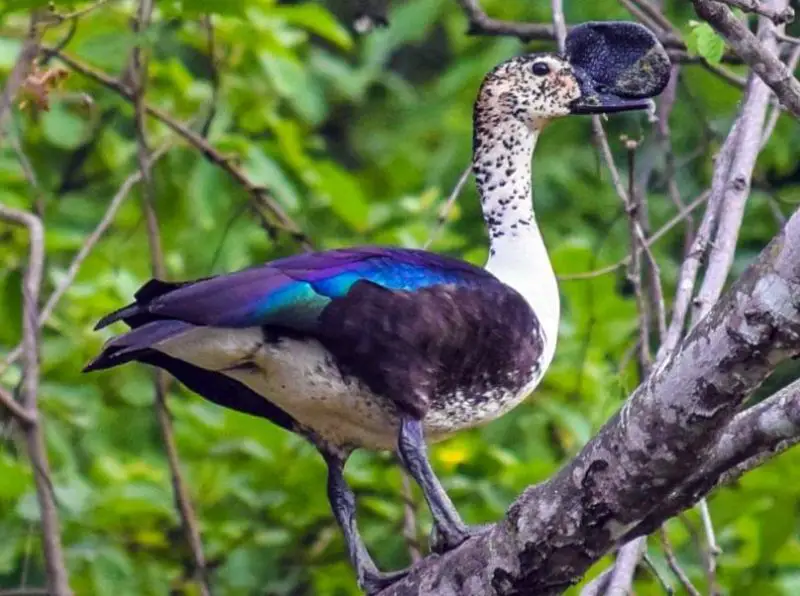
Comb Ducks (Sarkidiornis sylvicola) are notable for their impressive size and striking black and white coloration. Males and females share similar features, including a large black knob on the male’s beak, which is a prominent attraction trait. Males display green iridescence on their wings during courtship. They have mostly white heads with black spots, white chests, and black wings and backs. Females resemble males but have darker brown wings instead of black. Their heads are white with black spots, and their underbellies are gray-brown.
Steller’s Eider
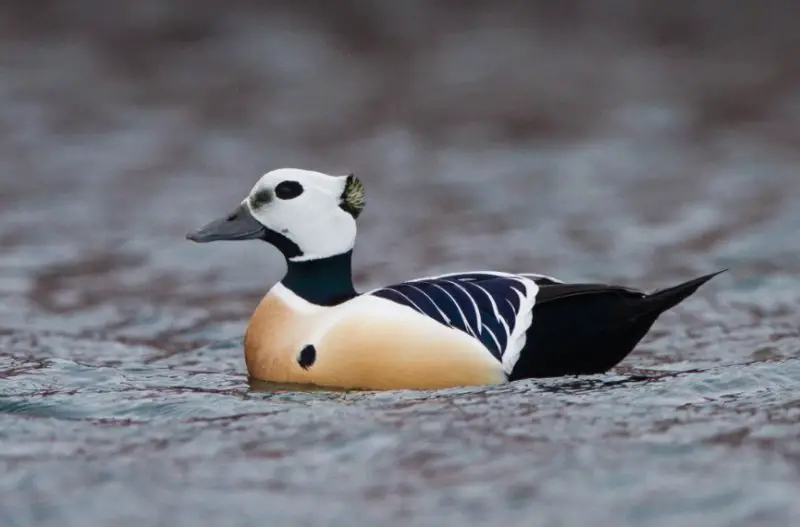
Steller’s Eiders (Polysticta stelleri) are distinguished by their black and white markings and inhabit remote tundra regions. Males display a white head with unique black patterns around the eyes and a crest at the back. They feature black beaks, necks, wings, and tails, with red-brown underbellies. Females are less colorful, with dark brown and black plumage. Variations in coloration occur seasonally and geographically across East and West Russia and Alaska. They are adept divers and gather in large numbers along Arctic shores for feeding and molting.
Magpie Duck

Magpie Ducks are distinctive for their black and white plumage, resembling the Common Magpie. Bred in Europe for their striking appearance, they feature a mostly white body with a black crest, wings, and tail. Their orange beak and legs provide a colorful contrast. Some variations also include blue and black hues. Originally bred for meat and eggs, they are now primarily bred for exhibition due to declining numbers in the United Kingdom and Europe.
Ancona Duck
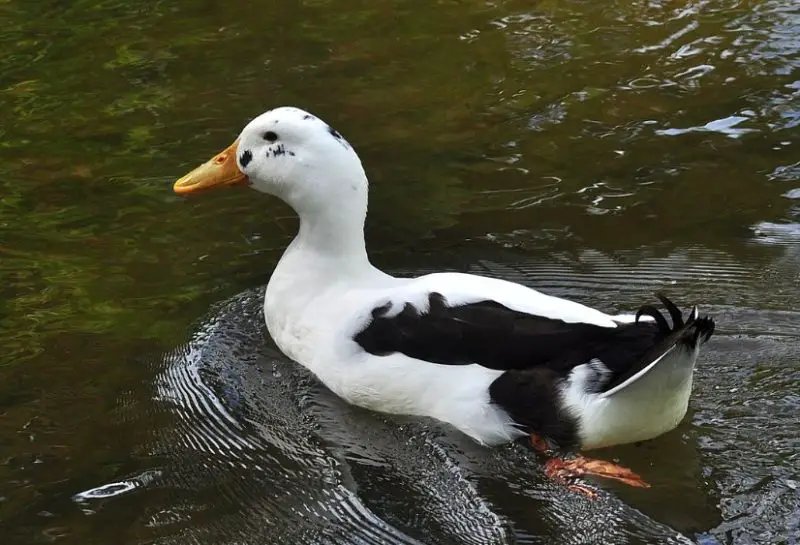
Ancona Ducks are known for their distinctive black and white plumage, with an almost fully white head adorned with random black dots or spots. Their neck and underside are white, while their wings feature predominantly black feathers with white patches on the inner wings. They may have either an orange or yellow beak, often with additional black patterning on the chest for those with yellow beaks. Ancona Ducks are prized for their prolific egg-laying capabilities, producing eggs that range in color from cream to blue or gray.
Swedish Blue
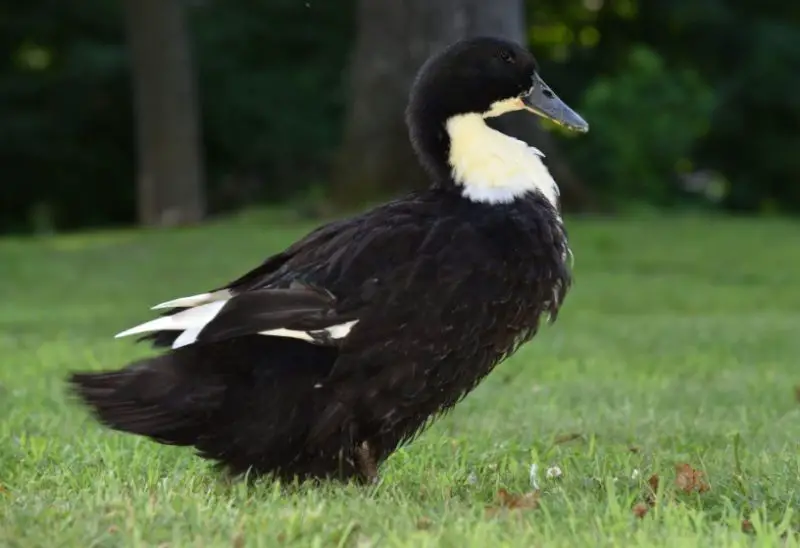
The Swedish Blue Duck is known for its three color patterns, including a black and white variant. These ducks predominantly feature black plumage with a distinctive white neck spot and gray undertones. Some individuals also exhibit blue hues, while others are mostly white. Swedish Blues are valued for their temperament, meat, and eggs, though breeding true blue ducks can be challenging. They are noted for their friendly nature, making them suitable for family settings, despite their occasional shyness.
Hook Bill
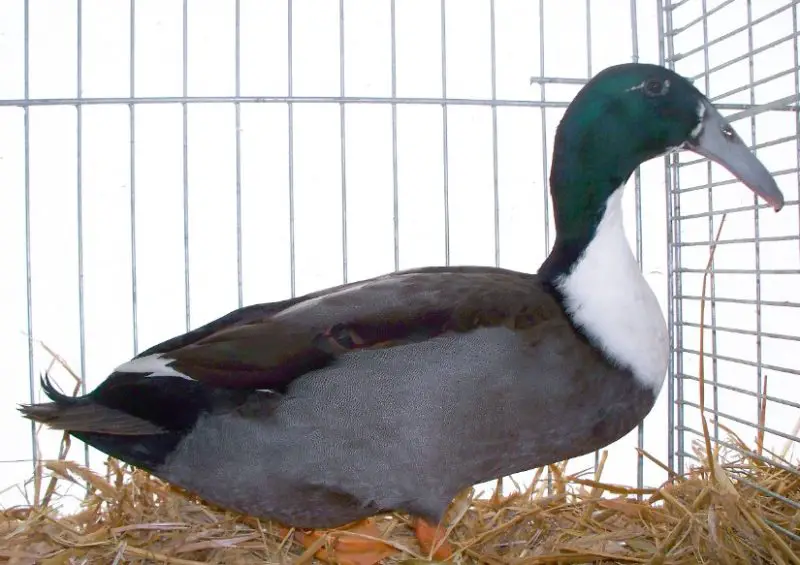
The Hook Bill duck, characterized by its long gray bill, green head, and disappearing presence in Europe, is predominantly black, gray, and white. Males feature distinctive black wings, a white chest and neck, and gray underbellies. Despite its historical documentation and egg-laying prowess of over 100 eggs per year, the Hook Bill remains relatively unpopular among domestic duck breeds. Its origin remains uncertain, contributing to its enigmatic status in aviculture.
Muscovy Duck

Muscovy Duck drakes (Cairina moschata) exhibit black and white coloration, with variations across their range in the Americas. Some are entirely black with white wing patches, while others sport a mostly white head with black markings. Their wings and undersides are typically black, and during breeding season, drakes may display a green sheen on their wings. The distinctive red facial skin contrasts with their overall dark plumage. Female Muscovy Ducks lay a modest number of cream-colored eggs annually.
Smew
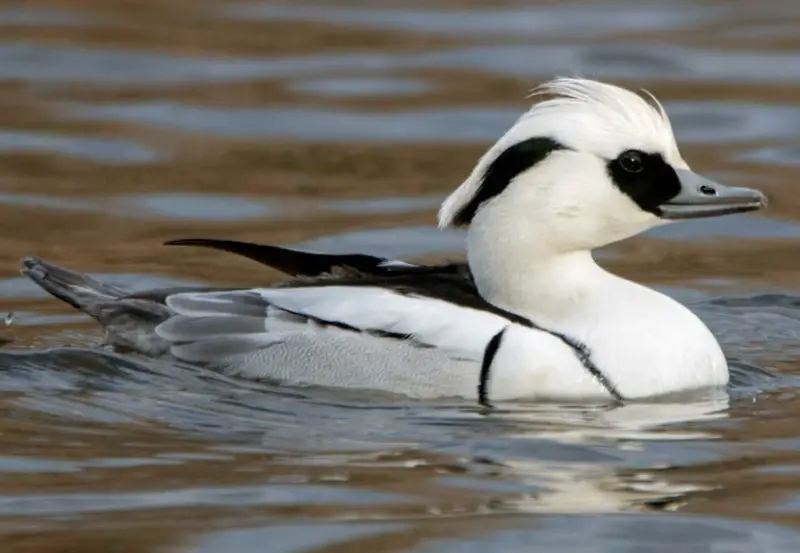
Male Smews (Mergellus albellus) are predominantly white with contrasting black patterns, including circles around their eyes, black upper backs, and thin stripes at the base of their wings. They have distinctive black beaks, similar to females. Females exhibit red-brown heads with gray and white plumage on their undersides and wings. During breeding, females develop black cheeks, while males may show gray wings. Smews migrate between Europe and Northern Asia, breeding across a wide territory extending to Japan, making them among the oldest duck species known.
King Eider
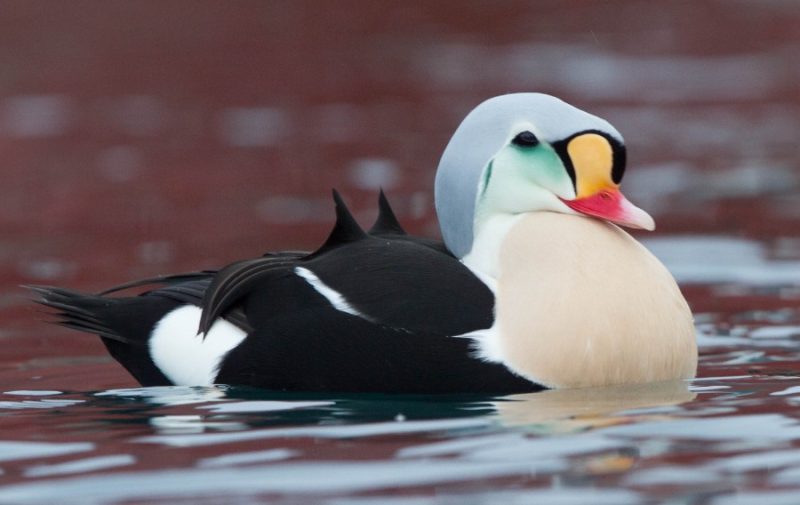
Male King Eiders (Somateria spectabilis) are distinguished by their unique, elongated heads adorned with white, gray, black, and yellow colors, and a bright red beak. They sport vibrant black and white plumage on their wings and bodies. Females are predominantly brown with a gray beak and lay white or cream-colored eggs in the summer. These ducks breed in Arctic tundra and inhabit the coastlines of Northern Europe, Asia, and Canada. Known for their varied calls resembling doves, males and females can live up to nearly two decades.
Radjah Shelduck
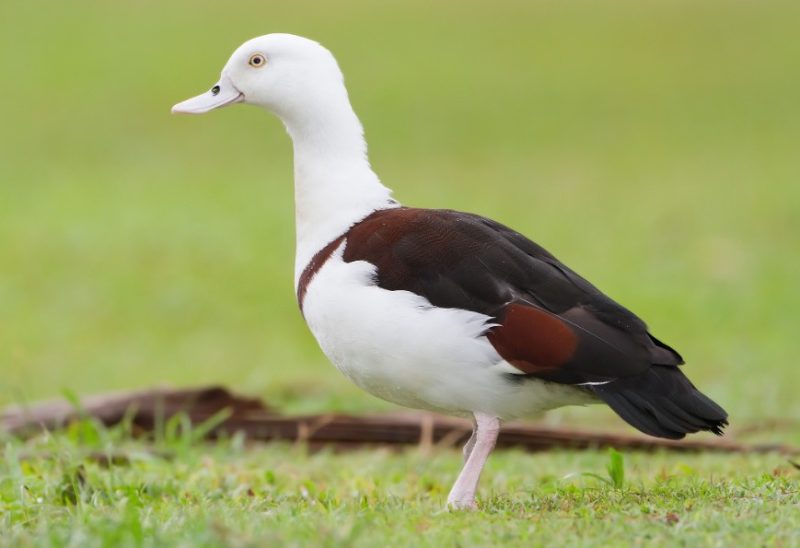
The Radjah Shelduck (Radjah radjah), found around Australia and sporadically up to Indonesia, is characterized by its black and white plumage. They have white heads, necks, and underbellies, contrasted by black backs, wings, and tails. Their beaks are bright cream-colored, with similarly bright irises. Females share a white and pink beak. These ducks feed on aquatic plants, weeds, insects, and worms. They inhabit coastlines and are easily spotted due to their striking coloration and habitat preferences.
Greater Scaup
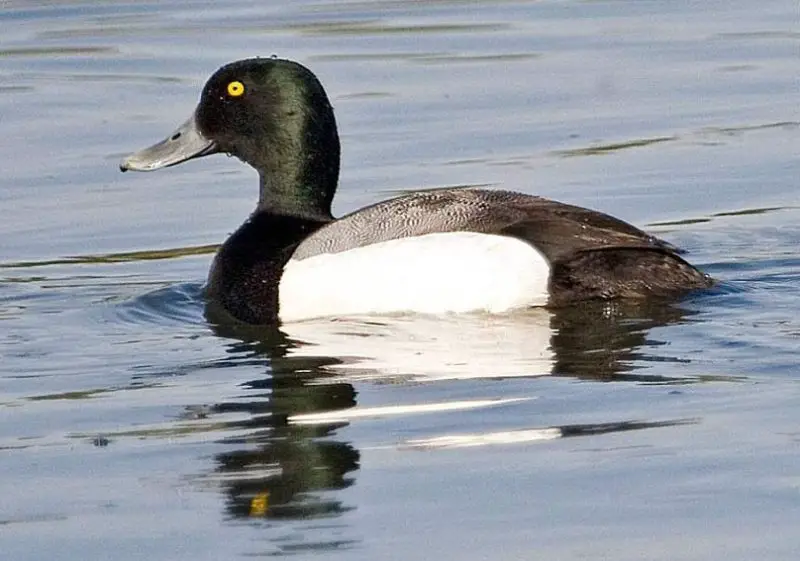
The Greater Scaup (Aythya marila), a large diving duck, is recognized for its black and white plumage and deep-diving capabilities. They feed on mollusks, seeds, and other foods, adapting to winter scarcity. These ducks grow up to 22 inches in size, displaying black heads with green iridescence during breeding. Their necks are black, their wings can be white or black, and they sport a bright blue beak and gray-black tail. Greater Scaups thrive in cool climates, including around the Arctic Circle, nesting among dense vegetation.
Surf Scoter
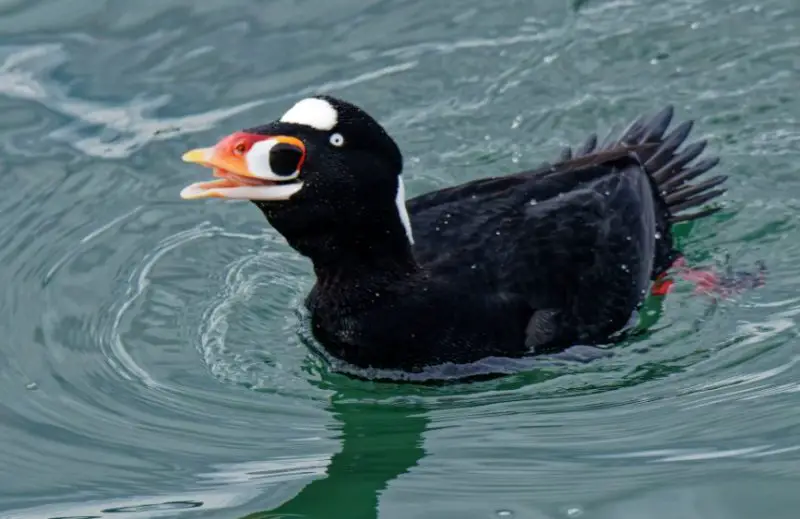
Surf Scoters (Melanitta perspicillata) are predominantly black ducks with notable white markings on their faces, backs of their heads, and the base of their orange beaks. Males feature black necks, wings, and undersides, while females are brown and black with black beaks. Found primarily in northern Canada, they migrate along the East and West Coasts of North America. Surf Scoters form pairs during migration, returning annually to the same breeding sites where they meticulously plan their departure dates based on migration distances.
Spectacled Eider
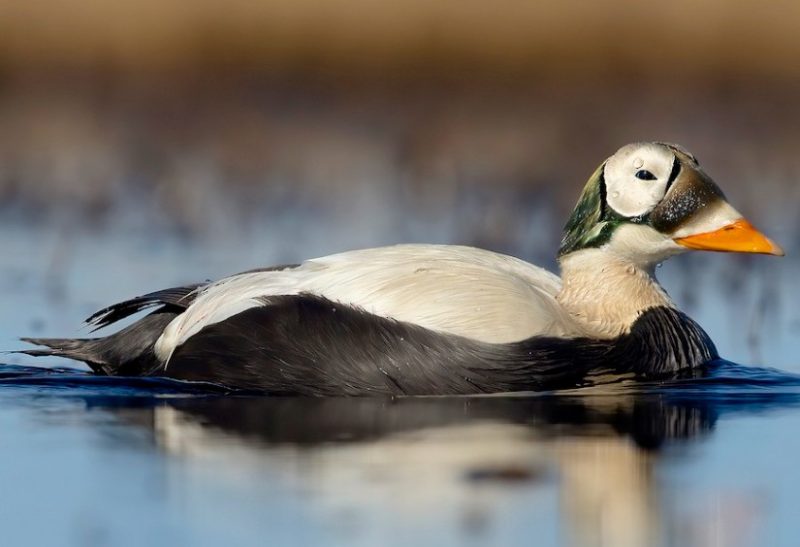
Spectacled Eiders (Somateria fischeri) are named for the distinctive white round patches around their mostly gray-green eyes, bordered by black margins. Male Spectacled Eiders sport bright orange beaks and exhibit black wings, underbellies, and white bases on their wings and upper backs. Females also have dark brown heads with bright brown spectacles and dark brown bodies with fine black lines. Found primarily in the Bering Sea region, these ducks build ground nests and lay green eggs.
White-Headed Duck
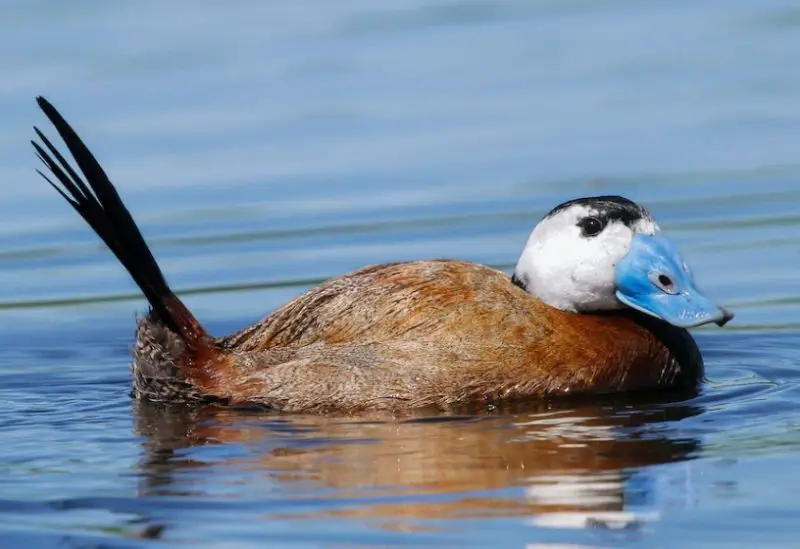
The White-headed Duck (Oxyura leucocephala) stands out among black and white-headed ducks for its predominantly white head adorned with black stripes. Male ducks feature a distinctive black crest-like band and a blue bill. Females have smaller white patches on their heads with gray-black bands and stripes. Both sexes display brown plumage. Partially migratory, these ducks move from Southeastern Europe to Central Asia and occasionally stray to India and Alaska. They excel at swimming and feed on various submerged plants in freshwater and sea environments.
Velvet Scoter
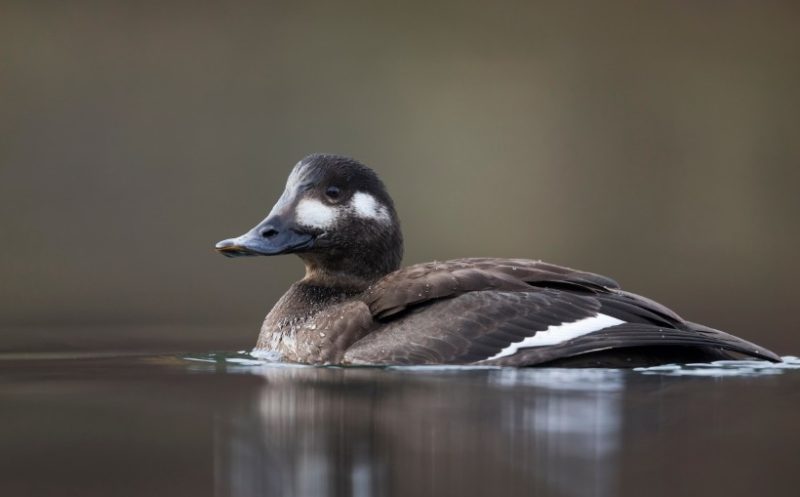
Velvet Scoters (Melanitta fusca) are predominantly black ducks with male heads adorned by thin white eye circles and bright yellow-orange beaks. They display white wing stripes amidst their black plumage. Females lack the eye circles and have black beaks, with bright brown areas near the beak. Both sexes exhibit white wing stripes. Found in Europe and Asia, Velvet Scoters are partially migratory, with Western Europe and East Asia marking their habitat limits. They winter in regions around the Black Sea and Caspian Sea.
Stejneger’s Scoter
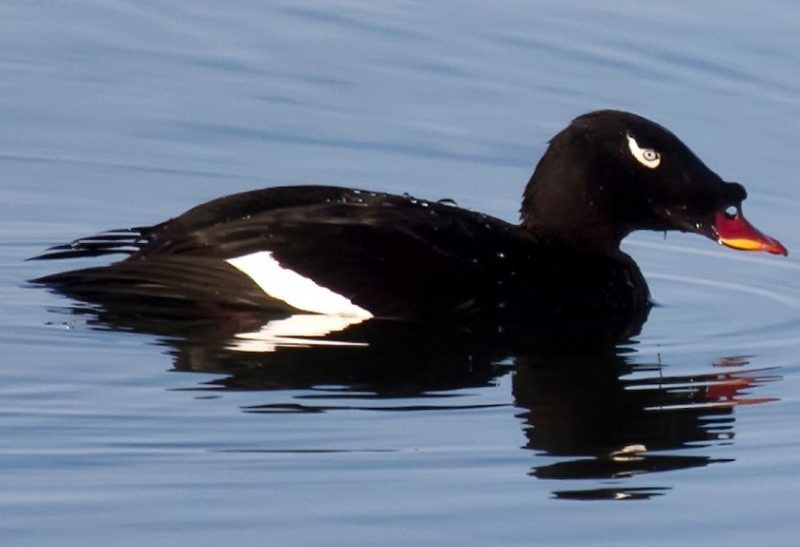
Stejneger’s Scoter (Melanitta stejnegeri), also known as the Siberian Duck, is predominantly black with small white markings around the eyes and on the wings. It features an orange beak amidst its dark plumage covering the head, neck, wings, and underbelly. Found primarily in northern Asia, it occasionally appears in northern North America, particularly Alaska, and central Asia, extending to China. These seaducks are adaptable, thriving in both freshwater and saltwater habitats, with much of their life history still being researched since their recent classification as a distinct species.
Common Merganser
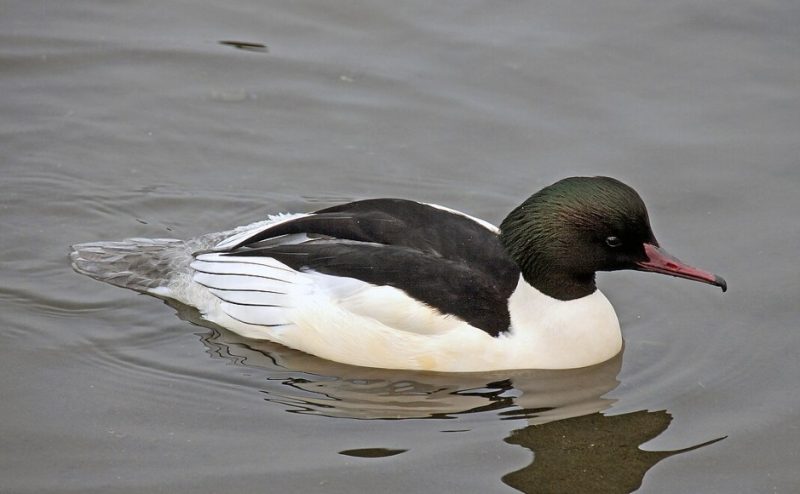
The Common Merganser (Mergus merganser) is distinguished by its striking black and white color combination. Males exhibit a black head, neck, and upper back, contrasting with a white belly and wings. This seaduck species is widespread across North America, Europe, and Asia, often moving between lakes seasonally. Females are more colorful than males, showcasing gray and red-brown tones and a particularly vibrant head during the breeding season.
Ring-Necked Duck
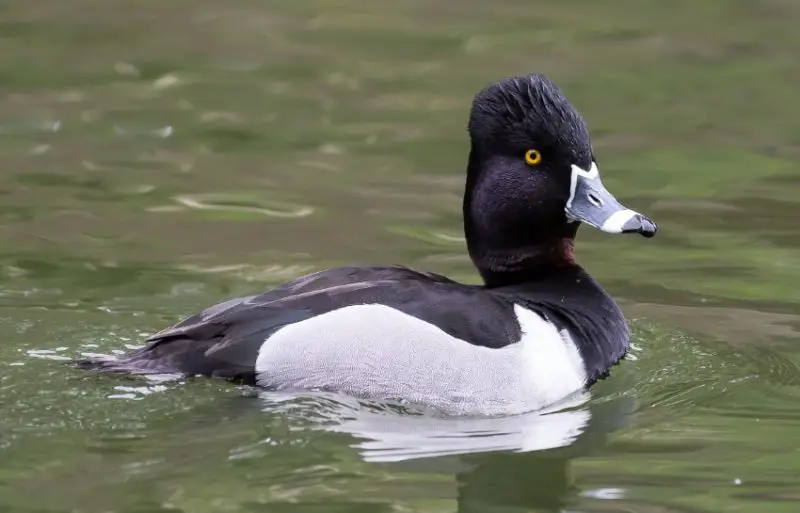
The Ring-necked Duck (Aythya collaris) inhabits freshwaters across North America, migrating from Canada to Central America. Males feature a black head, neck, upper back, and chest, with white bellies and wings. A narrow cinnamon-brown ring on the neck often distinguishes them, though it’s subtle. Females are primarily gray and black without the maroon neckbands. Young ducks favor insects, while adults dive for plants.
Hooded Merganser
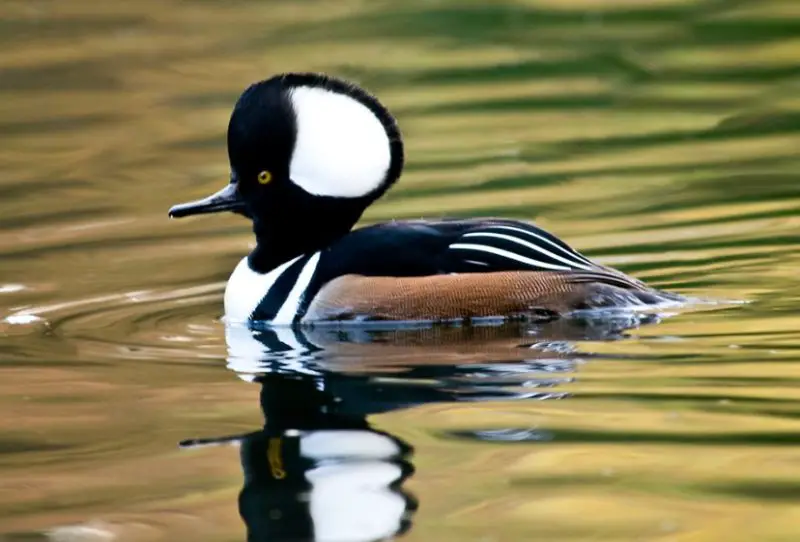
The Hooded Merganser (Lophodytes cucullatus) inhabits North America’s West and East Coasts. This species is less migratory compared to other North American ducks. Males are characterized by black and white plumage with brown sections on the belly. They have a black head, a thin sharp beak, and white patches on the sides of their head. Females feature a distinctively tall crest. Hooded Mergansers are specialized underwater feeders, consuming aquatic plants and small fish.
Tufted Duck
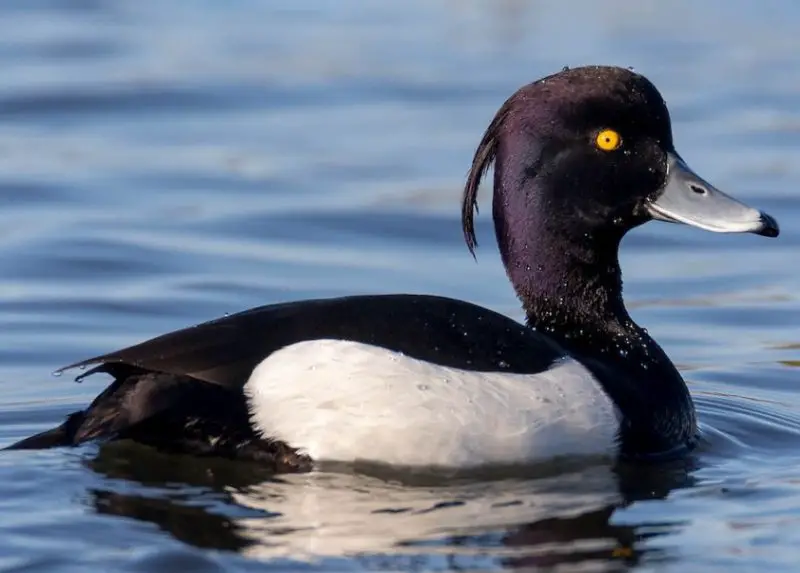
Tufted Ducks (Aythya fuligula) exhibit three main color patterns: males, females, and ducklings. Males are mostly black and white, with a black head and a distinct crest, vivid yellow eyes, and a white underbelly. Females are chestnut-brown, sharing the eye and beak color with males. Juveniles are gray-brown, resembling females. These nocturnal feeders rest during the day in calm coastal areas and ponds.
Red-Breasted Merganser

The Red-breasted Merganser (Mergus serrator) is easily recognized by its crested head. Males feature a black head, black crest, and red eyes during the breeding season, with gray, white, and black body plumage. Females have gray-brown heads and brown irises, along with a crest. Notably, these ducks can fly at speeds up to 100 miles per hour, aiding their extensive migrations. Over 10,000 Red-breasted Mergansers winter in the UK alone.
Scaly-Sided Merganser
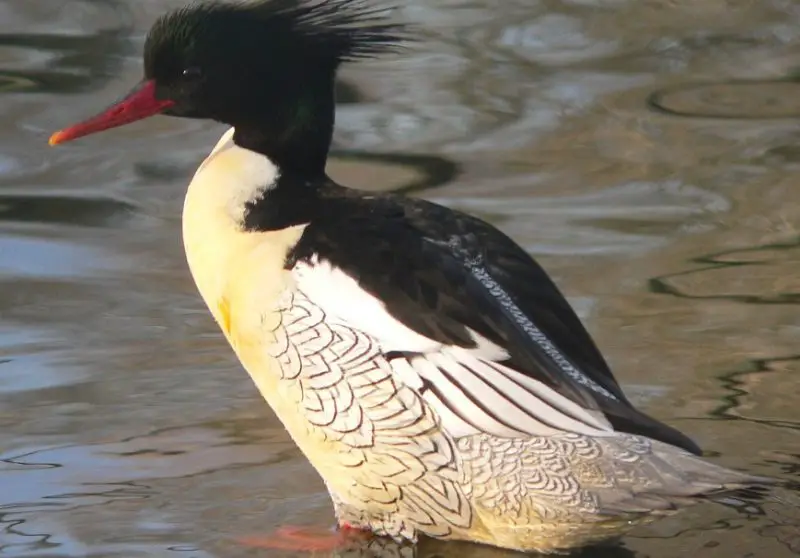
The Scaly-sided Merganser (Mergus squamatus) is distinguished by its black upperparts, including the head and back of the neck, contrasted with a white underside and yellow transition on the sides. Males feature a long, thin brown beak and a black crest at the back of the head. Females have a brown head with black eye patches, a long red-brown beak, and gray and white plumage. Found in rivers, females lack the black wing and back markings of males, appearing gray rather than black and white while swimming.
White-Winged Duck
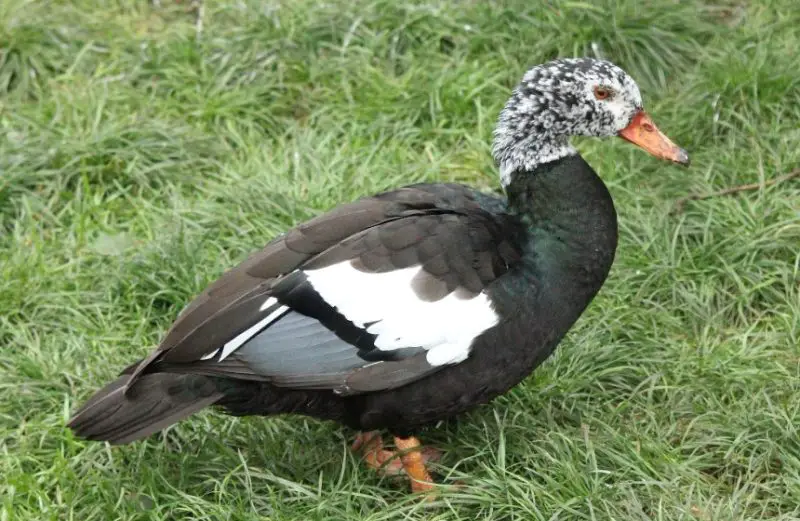
The White-winged Duck (Asarcornis scutulata), found predominantly in Southeast Asia extending to Indonesia, is distinctive among black and white ducks. Both males and females have predominantly white heads, with males featuring pale gray spots and dark brown beaks complemented by red irises. They exhibit dark brown and black plumage. Females resemble males but have larger gray spots on their heads, orange-brown eyes, and matching beaks. Their bodies and wings are brown, with additional black and white markings. Females are also smaller than males.
Canvasback

The Canvasback (Aythya valisineria), one of North America’s largest ducks, reaching up to 22 inches, displays distinctive brown, black, and white plumage in males. Males feature a brown and black head with a black upper back, gray wings with white bases, and black tips. Females sport varied shades of brown, with only the lower neck showing brown-black coloring. Once popular on North American menus, Canvasbacks now breed in protected areas to safeguard their populations, though they are not fully protected everywhere today.
Harlequin Duck
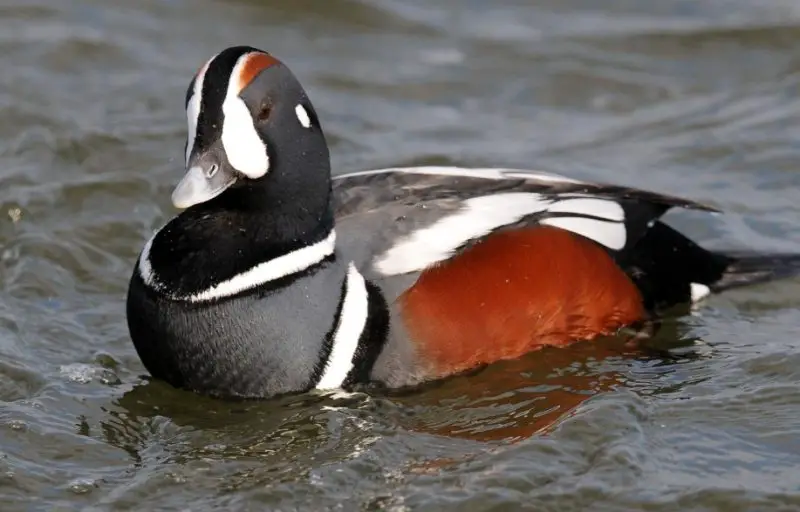
The Harlequin Duck (Histrionicus histrionicus) is known for its vibrant, multicolored appearance. Males display a striking combination of gray, black, white, and red on their heads, including a black crest with white and gray margins. Their chests feature gray with black and white stripes, and their wings sport red and red-brown sections. Females are predominantly brown with small black and white head markings. They often form stable breeding pairs that can last over two years, a behavior less common among ducks.
Knob-Billed Duck
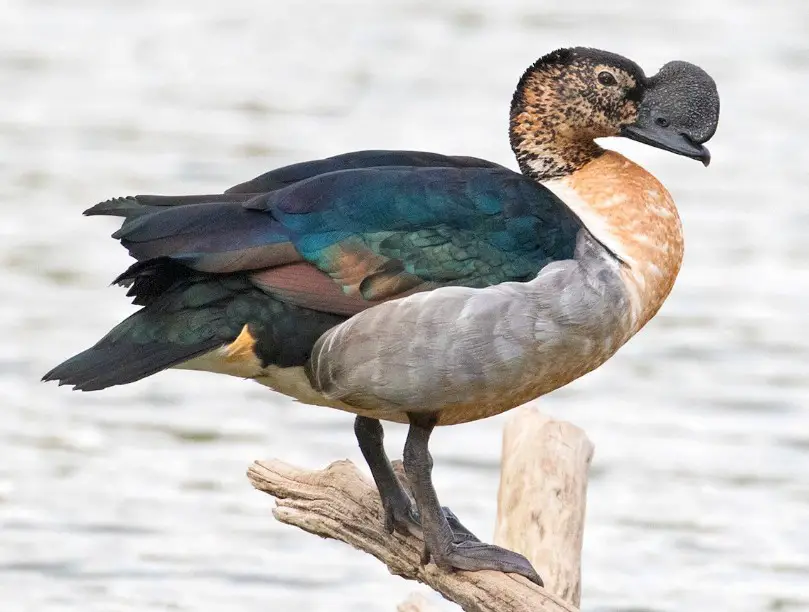
Knob-billed Ducks (Sarkidiornis melanotos) feature distinctive black-and-white plumage, with males sporting a prominent knob-like formation atop their black beaks. They have black heads and necks adorned with black spots, complemented by black wings, and a gray underside. Females resemble males but lack the knob on their beaks, sporting white heads and black wings. Rare variations include white and brown individuals in Africa. During breeding season, males may exhibit green iridescence on their black plumage, while both sexes display blue or violet iridescence on their wings and tails in South Africa.





